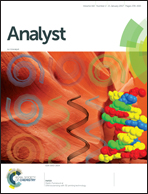Metal oxide semiconductor SERS-active substrates by defect engineering†
Abstract
A general route to transform metal oxide semiconductors from non-SERS active to SERS-active substrates based on defect engineering is reported. The SERS enhancement factor (EF) of metal oxide semiconductors like α-MoO3 and V2O5 can be greatly enhanced and the SERS performance can be optimized according to the detecting analyte and activating laser wavelength by introducing oxygen vacancy defects. The EF of R6G on α-MoO3−x nanobelts can be as high as 1.8 × 107 with a detection limit of 10−8 M, which is the best among metal oxide semiconductors and comparable to noble metals without a “hot spot”. A model, named “effective electric current model”, was proposed to describe the photo-induced charge transfer process between the absorbed molecules and semiconductor substrates. The EF of 4-MBA, R6G and MB on α-MoO3−x nanobelts with different oxygen vacancy concentrations calculated based on the model matches very well with experimental results. As an extension, some potential metal oxide semiconductor SERS-active substrates were predicted based on the model. Our results clearly demonstrate that, through defect engineering, the metal oxide semiconductors can be made SERS-active substrates with high stability and high biocompatibility.



 Please wait while we load your content...
Please wait while we load your content...